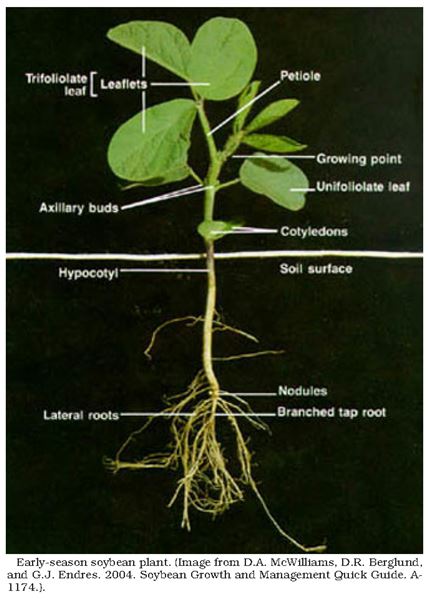Early-Season Soybean Growth
Soybean planting progress was reported 73% complete by the USDA, NASS Illinois Weather and Crops Report on June 14, which was actually 1% ahead of our 2008 progress but still 19% behind the 5-year average. Nearly half (49%) of soybeans are reported as emerged, and 91% of the emerged soybeans are reported to be in fair or better condition. I suspect that some of the earliest planted soybeans are developing the 3rd trifoliate (V3), while a majority of soybeans are developing the 1st trifoliate (V1). Under ideal conditions, plants will develop a new node (increasing Vstage) every 3 to 5 days. For the late- May and early-June planting dates, this is probably closer to 3 days for most soybeans this year.
Observation of soybean plants at these early growth stages should be focused on certain developmental areas of the plant. For instance, plants can look "bad" due to leaf defoliation from hail or insect damage (e.g., from bean leaf beetles) but be under little threat of yield loss. Many previous research experiments have shown that little yield loss occurs due solely to leaf defoliation until the reproductive growth stages. This is due to a high leaf area index compared to cereal grass crops like corn. However, damage from disease or insect feeding or other physical damage to the hypocotyl (the upper growing point in the stem, or primary meristem) could be more detrimental, although less visible. Whether you're evaluating soybean plant damage due to insect feeding or a hailstorm, look closely at these different plant developmental areas for damage and signs of growth and recovery.

Also, somewhere between the V1 and V3 growth stages is when yield loss due to weed competition could start to occur. This interval when soybean yields begin to be affected by weeds is known as the critical period of weed control. When postemergence applications of herbicides are delayed beyond the critical period, significant yield losses can occur.
Because fields vary in the weed species present and their densities, it is difficult to make broad rules about the amounts of yield lost per day. Weeds compete for light, water, and nutrients, and when the demand for these resources is small early in the growing season, weeds and soybeans can coexist without yield loss; this becomes less possible, however, as both the weeds and the soybean plants increase in size. In general, research has shown that the critical period of weed control starts between the V1 and V3 growth stages, or between the second and third week after planting. The length of time soybeans should remain free of weeds is usually 5 to 7 weeks, before the development of a full soybean canopy will begin to increasingly help suppress later-emerging weeds. Δ
VINCE DAVIS: Assistant Professor of Soybean Production Systems, University of Illinois